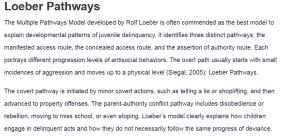Loeber Pathways
The Multiple Pathways Model developed by Rolf Loeber is often commended as the best model to explain developmental patterns of juvenile delinquency. It identifies three distinct pathways: the manifested access route, the concealed access route, and the assertion of authority route. Each portrays different progression levels of antisocial behaviors. The overt path usually starts with small incidences of aggression and moves up to a physical level (Siegal, 2005): Loeber Pathways.
The covert pathway is initiated by minor covert actions, such as telling a lie or shoplifting, and then advanced to property offenses. The parent-authority conflict pathway includes disobedience or rebellion, moving to miss school, or even eloping. Loeber’s model clearly explains how children engage in delinquent acts and how they do not necessarily follow the same progress of deviance.
I support Loeber’s model as it states that juvenile delinquency is not a uniform problem. It makes a great point of appreciating how family, self, and the environment influence human behavior. This multi-pathway view enables the development of more focused prevention efforts, recognizing that interventions on the pathways, especially the tasks, will need to differ.
For instance, action dictated by aggression in the overt pathway may require anger management. On the other hand, interventions provided for the covert pathway may require intervention in the area of honesty as well as dealing with peer pressure.
Considering real-life experiences, I have come across people who have chosen those paths. For example, one of the participants described a childhood friend who showed signs of the overt pathway. From fights in school compounds, his aggression level moved higher as grown up (Holtzman & Alexander, 2006; Siegal, 2005).
Another friend went through the concealed route, starting with theft from shops and advancing to credit card fraud. These examples show how the model can be applied and made viable in explaining and dealing with delinquent behavior. Overall, Loeber’s multiple pathway model allows insight into the various dynamic panels of juvenile crime and the foundation for creating appropriate strategies.
Reference
Siegal, L. J. (2005). Criminology: The Core. Cengage Learning
ORDER A PLAGIARISM-FREE PAPER HERE
We’ll write everything from scratch
Question
-
For this discussion, you will discuss the following questions:
- Do you agree with Loeber’s multiple pathways model? Do you know people who have traveled down those paths
Loeber Pathways
Textbook:


